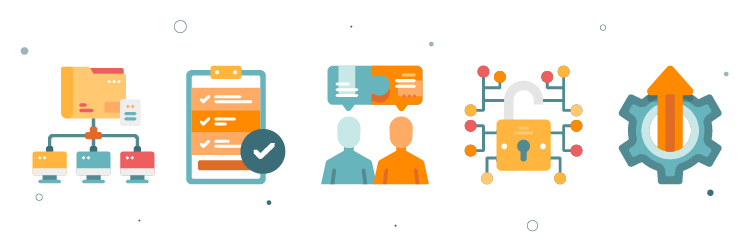High-precision screening. Fewer false positives. Explore our innovative solution for sanction list screening and see how ANWB does it >
Fragmented customer data costs time, leads to errors, and frustrates your organization. Discover
how to create an effective Single Customer View in five simple steps.
Organizations that handle large volumes of complex customer data often face the challenge of having information scattered across multiple systems. When departments work with fragmented data, it can lead to duplicated efforts, mistakes, and frustration for both employees and customers.
A Single Customer View (SCV) consolidates all customer information into one complete and reliable profile. This provides teams with instant access to consistent and up-to-date data, eliminating the need to waste time searching for or validating records.
But how can you implement such a system without a complex technical overhaul or launching a full-scale IT project? This article will show you how to build a SCV using your existing technology.
A Single Customer View (SCV) consolidates all customer data from various sources and systems into a single overview. It goes beyond merely collecting data; it also ensures that the information is accurate, up to date, and accessible to everyone who uses it.
The practical benefits of a SCV become evident in everyday scenarios. For instance, consider a financial institution conducting a risk assessment on a new customer. With the SCV, the analyst can access all relevant information, including customer identity, transaction history, and compliance checks, without consulting multiple systems. This streamlined access accelerates decision-making and minimizes risk.
A SCV allows organizations to make the most of their customer data. Especially in highly regulated sectors like finance, government, and insurance, where data quality and compliance are critical, a SCV is essential.
Here’s how a SCV adds strategic value to companies:

A well-built SCV offers organizations a wide range of operational advantages, including:
Customers appreciate not having to repeat their story to different departments. With a SCV, employees have a full view of the customer’s profile, including previous interactions and preferences. This enables more personalized service and prevents frustration, whether the customer calls, emails, or meets in person.
Employees waste time searching and verifying information when customer data are spread across systems. An SCV prevents that. All relevant data are centrally available in one place, increasing efficiency and reducing errors. That means lower operational costs and higher productivity.
Data and privacy regulations are becoming stricter. A SCV helps you understand what customer data you hold, who has access to it, and how it's being used. That makes complying with GDPR, AMLD, and other regulations easier. Plus, it supports fraud detection by making unusual patterns easier to spot.
Implementing a SCV may sound like a large project, but you don’t have to start from scratch. By making clever use of your current systems and data, you can set up an effective SCV in five steps:

A Single Customer View doesn’t have to be a complicated trajectory. With the right technology and smart use of your existing systems, you can build a reliable and efficient SCV that really works.
Human Inference helps you get there. For over 35 years, we’ve supported organizations in gaining control of their customer data. Our software integrates seamlessly with your existing systems and ensures your data is accurate, complete, and usable.
Using techniques like fuzzy logic and natural language processing, we improve data quality and precision while helping you confidently meet regulatory requirements.

A Single Customer View is more than just a central customer view. Want to explore an approach that fits your organization and your systems together? We’d be happy to help, from strategy to implementation.
Share your details and feel free to ask us a question. We’ll contact you shortly to help.
Tell us what you'd like to learn more about.
Share your details and feel free to ask us any questions about DataHub. We’ll get back to you shortly.
Share your details, and Danny will reach out shortly to address your question.
Share your details and feel free to ask any questions about DataHub. We'll get back to you shortly.
Share your details and feel free to ask us any questions about DataPlatform. We’ll get back to you shortly.
Share your details, and Danny will reach out shortly to address your question.
Share your details and feel free to ask any questions about DataHub. We'll get back to you shortly.
Share your details and feel free to ask us a question. We'll get back to you shortly.
Share your details, and one of our data experts will reach out to discuss our services and support with you soon.
Share your details and feel free to ask us a question. We'll get back to you shortly.
Share your details, and we’ll reach out soon to tell you more about who we are and how we work together.
Share your details and feel free to ask us a question. We'll get back to you shortly.
Leave your details and feel free to ask us any questions. We will respond quickly to discuss your needs, whether you seek advice or want to learn more about our solutions.
How do you screen over 5 million members and remain compliant without getting bogged down in manual work? In this case, you'll learn how ANWB combines fault-tolerant matching with automated workflows to enhance precision, minimize manual reviews, and ensure audit readiness at all times.
This guide will help you quickly identify and resolve critical bottlenecks in sanction list screening. It includes five recognizable questions and three clear signals, all centered around one integrated solution that effectively works in practice.